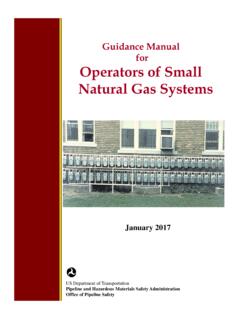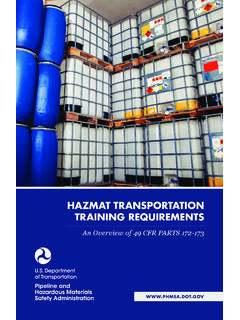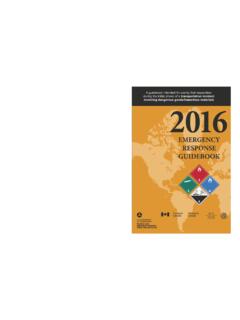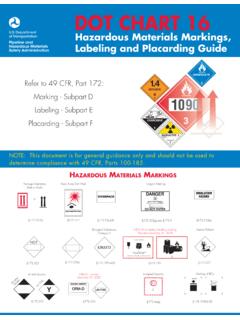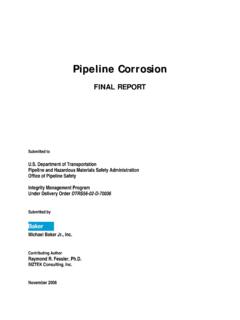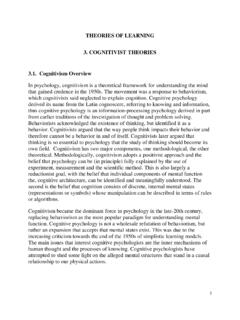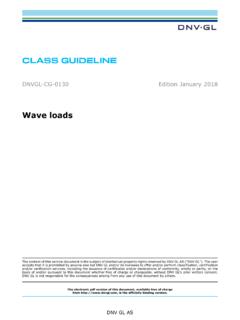Transcription of Self-Contained Breathing Apparatus (SCBA)
1 Self-Contained Breathing Apparatus (SCBA). Cylinder Life-Extension Study FINAL REPORT. Prepared by: CACI: David Flage David Hunter Steve Robinson Blackstone Group, LLC: Robert Ceres Digital Wave Corporation: Michael Gorman Steven Ziola Under Contract: N00024-11-C-4314. August 2012. Self-Contained Breathing Apparatus (SCBA). Cylinder Life-Extension Study Table of Contents 1 Executive Summary .. 1-1. 2 SCBA Background .. 2-1. 3 Study 3-1. Overall Approach and Study Design .. 3-1. ISO 11119-2 Tests Not Accomplished and 3-2. ISO 11119-2 Tests Accomplished with Noted 3-3.
2 Additional Testing Conducted, Not Required by ISO 3-5. Study Execution and Results .. 3-5. 4 Findings and 4-1. 4-1. 4-2. 5 5-1. 6 References .. 6-1. Appendices Appendix A SCBA Hydrostatic Test Data Analysis .. A-1. Appendix B Digital Wave Corporation SCBA Study Technical Report and Data ..B-1. Appendix C SCBA Study Weekly Status Appendix D Business Case Analysis of SCBA D-1. Appendix E SCBA Data Review with Brief to DOT (19 June 2012) ..E-1. List of Figures Figure 3-1 Full Pressure Hold .. 3-3. Figure 3-2 Quiescent Hold .. 3-4. List of Tables Table 3-1 Navy Shipboard SCBA Cylinder Variants.
3 3-1. SCBA Cylinder Life-Extension Study, Final Report (August 2012) ii 1 Executive Summary This study supports the use of an alternative technology, modal Acoustic Emissions (MAE), to extend Self-Contained Breathing Apparatus (SCBA) cylinder service life for an additional 15 years. Use of MAE technology could help the Navy avoid $50 Million in cylinder replacement costs that would otherwise occur over the 2013 2025 time period. The Navy maintains approximately 50,000 SCBA cylinders for use in shipboard firefighting and damage-control service.
4 Service life for SCBA cylinders is currently limited to 15 years by Department of Transportation (DOT) Code of Federal Regulations and Special Permits issued to SCBA. cylinder manufacturers. Navy large-scale SCBA cylinder purchases started in 1998; these cylinders begin reaching the end of their 15-year service life in 2013. The SCBA cylinder study challenged the 15-year service-life limit by using new technology that identifies nonvisible flaws or weaknesses in cylinders. Prior to this study, the 15-year service-life limit combined with hydrostatic testing was thought to ensure safe cylinder service.
5 This study showed that the current DOT SCBA cylinder 15-year service-life limit does not meet the rules of Reliability- Centered Maintenance (RCM) applicability per MIL-STD-3034 (RCM Process) because there is no increase in the probability of failure at a specific age ( , no evidence of wear-out). Hydrostatic testing fails to find nonvisible flaws or weaknesses that may propagate during continued use, but modal Acoustic Emissions testing detects these flaws. The Navy's Common Maintenance Planning Working Group (CMPWG), the study sponsor, worked closely with DOT to develop a study test plan and to review results.
6 The goals of the study were to conclusively address two questions to determine whether SCBA cylinder service life can be safely extended. The questions were: 1. Do Navy SCBA cylinders have the long-term strength and integrity required to safely withstand fill cycles associated with extending their service life beyond the DOT 15-year maximum? 2. Can modal Acoustic Emissions testing be used to predict impending failure in time to allow for failing cylinders to be safely removed from service? The answer to both questions is yes. The case for requesting service-life extension is supported by extensive engineering tests.
7 The tests included SCBA cylinder cycling to mimic extended service life and burst testing to determine ultimate strength of end-of-life, cycled, and damaged cylinders. SCBA. cylinder strength does not degrade with calendar age or pressure cycles at operational pressure. The study induced a full range of physical damage to cylinders to determine the effectiveness of modal Acoustic Emissions testing. The testing revealed a linear relationship between a cylinder's acoustic signature and ultimate burst pressure. modal Acoustic Emissions testing is also effective at identifying discrete material flaws that correlate to individual cylinder burst pressure.
8 This report describes work performed for as well as findings and recommendations from the SCBA. Cylinder Life-Extension Study. The study was conducted for the Navy's Common Maintenance Plan- ning Working Group (CMPWG) chaired by NAVSEA 04RM21 under auspices of the Maintenance Engineering Division (NAVSEA 04RM). Fleet Forces Command funded the study, which was executed from January 2012 through June 2012 (with documentation following). This study was under- taken as part of a larger Common Maintenance Requirement (CMR) Alignment Maintenance Effec- tiveness Review (MER) of Navy firefighting SCBA equipment.
9 This document describes the reasons for undertaking the SCBA cylinder life-extension study, the design and conduct of the study, results, findings, and technical recommendations. Navy programmatic issues associated with implementation of the technical recommendations are beyond the scope of the study and are not included in this report. SCBA Cylinder Life-Extension Study, Final Report (August 2012) 1-1. 2 SCBA Background Navy shipboard SCBA cylinders are fabricated with an aluminum-alloy tank that is fully wrapped with either glass fiber-reinforced polymer (GFRP, also known as fiberglass) or carbon fiber- reinforced polymer (CFRP).
10 The older cylinders are GFRP-wrapped, and tensile stress is shared by the GFRP and the aluminum alloy. The newer cylinders are wrapped with the considerably stronger CFRP. On CFRP cylinders, the aluminum alloy serves as an impermeable gas barrier, not a strength member. Tensile stress is therefore carried predominantly by the CFRP wrap, allowing the aluminum-alloy cylinder to be considerably thinner than in fiberglass-reinforced cylinders. Furthermore, the different construction materials have different characteristics ( , fiberglass cylinders are more susceptible to stress ruptures).



